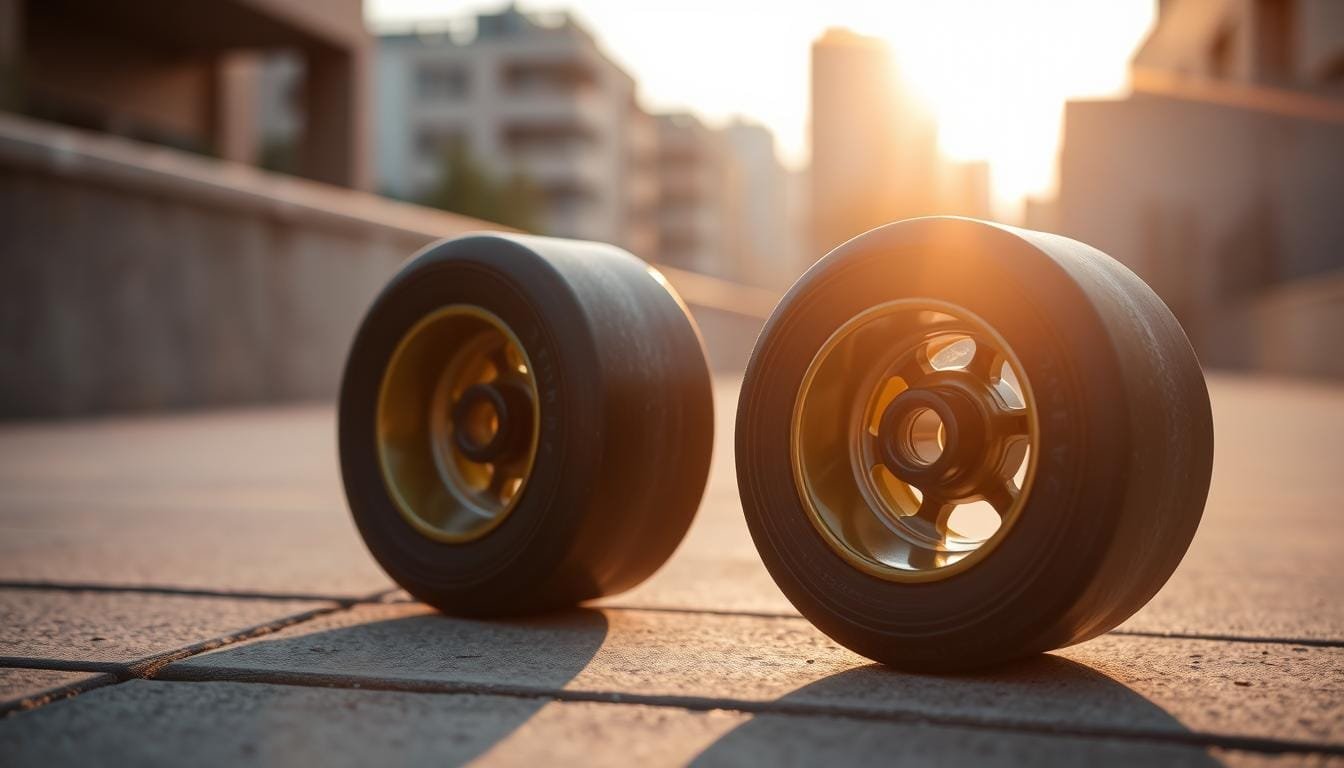When you start street skating, you’ll hear about “99A.” It means how hard skateboard wheels are. But, is 99A good for skating on streets? We need to know how wheel hardness changes the way you skate. Different surfaces need different types of wheels.
Skate wheels for the street are usually 99A. This level is great because it grips well on asphalt and concrete. These are the grounds you find in cities. Wheels at 99A are suggested for both newbies and those a bit more skilled. They offer a great mix of being hard enough for tricks but still having grip.
Key Takeaways
- 99A is a common durometer rating for street skating wheels.
- Street and park wheel durometer typically range from 95A to 101A.
- 99A wheels offer balance in hardness and grip.
- Ideal for beginners and intermediate street skaters.
- Hardness level impacts trick performance and surface handling.
Understanding 99A Durometer Ratings
Understanding the durometer scale is key when looking at skateboard wheel hardness. It measures the hardness of polyurethane skateboard wheels. This affects how they perform.
99A wheels are on the high end of the Durometer A Scale, which goes from 75A to 101A. They balance grip for tricks and speed for smooth riding. This makes them a top pick for street skaters.
Skateboard wheels are usually 50-75 mm big. Smaller wheels (50-53 mm) are better for trick riding because they’re slower. Larger wheels are for those who want speed and smoothness on rough paths. The average rating for wheels is 99A. This range, 96A-99A, is great for new skaters and works well on different surfaces, like streets and skate parks.
Hard wheels (above 99A) are best for sliding and keeping up speed on smooth areas. But softer wheels (78A-87A) are better for cruising on rough ground. Yet, 99A wheels offer a middle ground for versatility in both city and skate park places.
In conclusion, knowing about 99A wheels helps skaters choose wisely. They match well with street skating styles and environments. They are a solid pick for those wanting to do various tricks and moves.
Advantages of 99A Wheels for Street Skating
99A wheels are excellent for both street skating and skate parks. They offer a great balance of speed and grip. This balance is crucial for your skateboard to perform well. You can go faster than with softer wheels but still handle cracks, pebbles, and other challenges in the city.
These wheels are hard and sized between 50-54mm, which makes sliding smoother. This feature helps a lot with technical tricks. Because they’re tough, they don’t wear out as quickly. This means they last longer, even on rough asphalt and sidewalk edges.
99A wheels boost your overall skateboard performance, making street skating more fun. They provide the stability newbies need and the durability seasoned skaters desire. For more on this, read this Skateboard Wheels Buying Guide.
| Wheel Type | Diameter | Durometer | Recommended Use |
|---|---|---|---|
| Street Wheels | 50-54mm | 99A+ | Technical Stunts, Obstacle Navigation |
| Cruiser Wheels | 54-60mm | 78A-90A | Cruising, Commuting |
| Longboard Wheels | 60-75mm | 75A-85A | Grip, Shock Absorption |
Disadvantages of 99A Wheels
99A wheels are great for street skating but have their downsides. Their hardness causes vibrations and a rough ride on bumpy grounds. This can make skating for a long time uncomfortable and affect your control.
They also have less grip in wet conditions, making them slippery. Skaters might have to change their skating style or switch to softer wheels for better hold. These issues mean 99A wheels can be tricky in bad weather.
Lastly, the high durometer of 99A wheels makes them less smooth on different surfaces. They don’t absorb shocks well, leading to more stress for the skater. While they are good for certain skate styles, knowing these downsides is important for skaters.
Choosing the Right Wheels for Your Style
Your skateboarding style and the surfaces you ride on are key when picking skateboard wheels. For street skaters on smooth surfaces, 99A wheels are often best. They offer a good balance of grip and slide, perfect for street skating and park tricks. But if you like cruising or riding on rough surfaces, think about softer wheels or cruiser wheels.
Picking the right wheel size is essential too. Smaller wheels, from 50mm to 53mm, are stable and great for street tricks and petite riders. For beginners or bigger riders, wheels sized 54mm to 59mm provide speed and control, good for both street and park skating. Longboarders or downhill skaters should look at wheels 60mm or larger for the best speed and handling on tough terrains.
Knowing about wheel material and hardness is important as well. Soft wheels (78A-87A) work well on rough surfaces, moving smoothly over bumps. Slightly harder wheels (88A-95A) mix speed and grip well, for various surfaces. Beginners on smooth surfaces will find wheels rated 96A-99A to be ideal, offering a solid mix of speed and grip.
Some street skaters like using cruiser wheels for their light weight and grip on slick surfaces. If you’re interested, you can learn more about fitting cruiser wheels on your board, even though they make tricks harder and slower.
Knowing these details helps you make better choices. By picking the right wheels for your style, you’ll do better and have more fun skating.
Comparing 99A with Other Durometer Ratings
When looking at skateboard wheel comparison, 99A is a top pick. It’s speedy but still grips well, perfect for many places. Wheels softer than 99A, like 88A to 95A, grip better. They work great on rough spots by making rides smoother and more controlled. But, they are slower which might not be best for fancy tricks.
On the other hand, durometer differences show that hard wheels, 100A and up, are fast but lack grip. These shine on smooth areas, like indoor skateparks. For those who love speed and street skating, Bones STF or Spitfire F1 Street Burners are ideal. Bones SPF and Spitfire F1 Park Burners are for park skating enthusiasts.
Choosing skateboard gear means also looking at wheel size. Small wheels (50-53 mm) are stable for tricks and suit smaller riders. Mid-size wheels (54-59 mm) give a good mix of speed and balance. They’re great for new and big riders alike. Big wheels (60 mm or more) are for those needing speed on uneven ground.
Here’s a detailed table that further illustrates the differences in durometer ratings:
| Durometer Rating | Characteristics | Ideal Use |
|---|---|---|
| 78A – 87A | Very soft | Cruising, longboards |
| 88A – 95A | Soft | Street and rough surfaces |
| 96A – 99A | Medium hard | Street skating, smooth surfaces |
| 100A – 101A+ | Hard | Indoor parks, technical skating |
| 83B – 84B | Extremely hard | Technical, very smooth surfaces |
The go-to durometer rating for skateboard wheels is 99A. It’s the standard for many skaters. By understanding different ratings and knowing your skating style, you can choose the right skateboarding gear. This helps you skate better, from rough streets to smooth parks.
Conclusion: Is 99A Right for You?
Choosing the right wheel hardness, or durometer, is key for street skating. With a 99A rating, these wheels balance speed, grip, and durability. This mix is great for tricks and skating on smooth surfaces like you find at skate parks. The Spitfire Classic Series and Ricta McCoy Pro wheels are perfect examples at 99A. They meet the needs of many skaters wanting consistency and control.
But think about what you need and where you skate. Softer wheels might be better if you skate on rough terrain or want more comfort. Wheels ranked from 78A to 85A are softer. They absorb shocks well and are smoother on tough surfaces. For skating on different kinds of terrains, medium wheels sized from 55mm to 59mm and rated from 88A to 95A are adaptable.
Finding the right skateboard wheels is a personal process. It might take some experimenting with different setups to figure out the best wheels for you. Whether you’re doing tricks on the streets or at the skate park, knowing your skate setup helps make good choices. The perfect durometer for street skating fits your own style and goals, making every skating session better.

I’m John Peterson, a passionate skater, blogger, and lifelong enthusiast. I’ve been skating for over 9 years and have gone on to write a blog dedicated to the sport of skating and its culture. Through my blog, I strive to share my knowledge and experience of the sport with all who are interested. From beginner tips, tricks, and equipment reviews to interviews and event coverage, I cover it all. So read my blog as I explore the wonderful world of skating!

